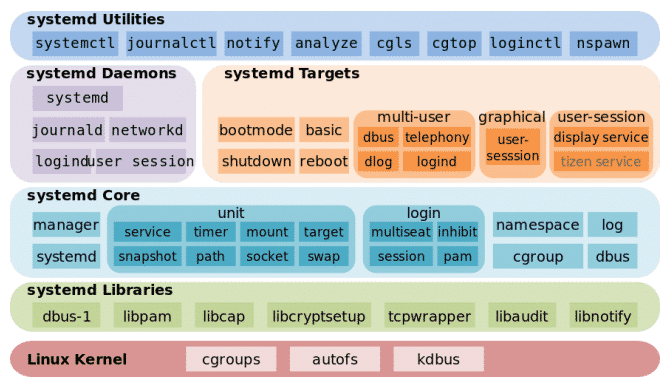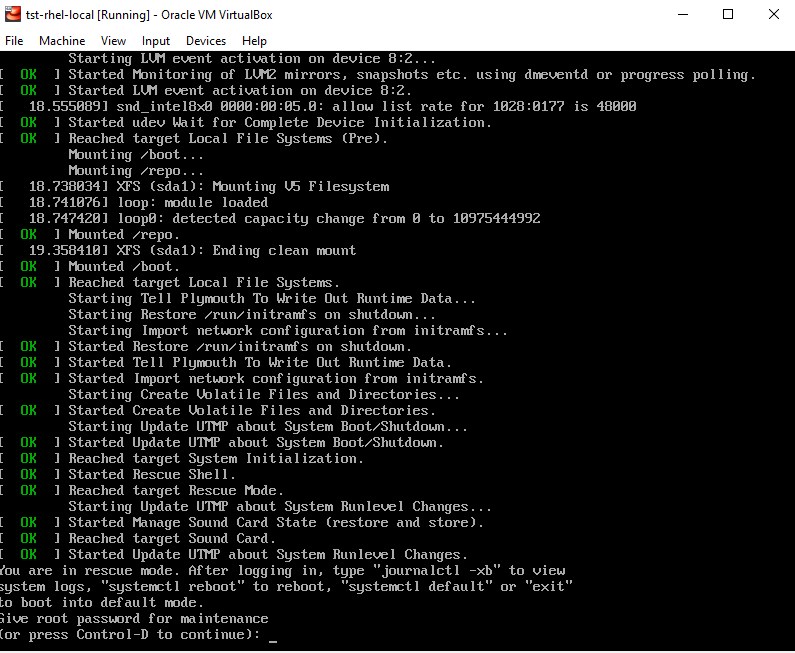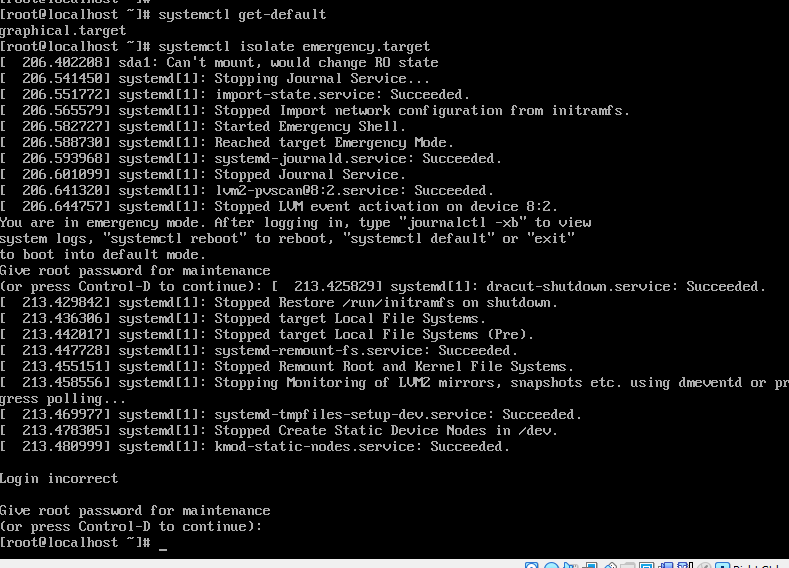Systemd and sysvinit
Systemd
Systemd is a system and service manager for Linux operating systems, designed to replace the traditional SysVinit system. It provides a more efficient and flexible way to manage system processes, startup services, and system states. Systemd introduces the concept of units and targets, which offer a modular and unified approach to system configuration and management.
- Systemd is the manager of everything after the Linux kernel starts.
- Managed systems are called units.
- Different unit types include:
- services
- mounts
- timers
- etc.
systemctl is the management interface to work with systemd.

systemd vs sysv init
From Differences between SysVinit, Upstart and Systemd:
Systemd is the replacement of the SysVinit and Upstart initializer programs. In RHEL6, the Upstart initialization program was used. Before RHEL6, the SysVinit was the default initialization program.
This diagram also shows the different systemd components:

The sysv init contains various scripts:
$ ll /etc/rc*
lrwxrwxrwx. 1 root root 10 Jul 27 2021 /etc/rc0.d -> rc.d/rc0.d
lrwxrwxrwx. 1 root root 10 Jul 27 2021 /etc/rc1.d -> rc.d/rc1.d
lrwxrwxrwx. 1 root root 10 Jul 27 2021 /etc/rc2.d -> rc.d/rc2.d
lrwxrwxrwx. 1 root root 10 Jul 27 2021 /etc/rc3.d -> rc.d/rc3.d
lrwxrwxrwx. 1 root root 10 Jul 27 2021 /etc/rc4.d -> rc.d/rc4.d
lrwxrwxrwx. 1 root root 10 Jul 27 2021 /etc/rc5.d -> rc.d/rc5.d
lrwxrwxrwx. 1 root root 10 Jul 27 2021 /etc/rc6.d -> rc.d/rc6.d
lrwxrwxrwx. 1 root root 13 Dec 10 09:31 /etc/rc.local -> rc.d/rc.local
Does systemd also rely on these sysvinit scripts?
Systemd has its collection of configuration files which are composed of unit and target files. The sysvinit scripts can be deleted, but it is recommended to maintain backwards compatibility since some services in the system may still expect those files to exist.
Systemd Units
The configuration files for systemd can be found in /lib/systemd/system:
$ ls /lib/systemd/system
To see all unit types that can be managed through systemd:
[root@tst-rhel ~]# systemctl -t help
Available unit types:
service
socket
target
To get an overview of units:
systemctl list-unit-files
systemctl list-units
Systemd Units vs. Targets
The individual files are considered units, while a target is a collection of units.
$ ls /lib/systemd/system/*.target
/lib/systemd/system/basic.target /lib/systemd/system/kexec.target /lib/systemd/system/runlevel4.target
/lib/systemd/system/bluetooth.target /lib/systemd/system/local-fs-pre.target /lib/systemd/system/runlevel5.target
/lib/systemd/system/boot-complete.target /lib/systemd/system/local-fs.target /lib/systemd/system/runlevel6.target
/lib/systemd/system/cloud-config.target /lib/systemd/system/multi-user.target /lib/systemd/system/selinux-autorelabel.target
/lib/systemd/system/cloud-init.target /lib/systemd/system/network-online.target /lib/systemd/system/shutdown.target
/lib/systemd/system/cryptsetup-pre.target /lib/systemd/system/network-pre.target /lib/systemd/system/sigpwr.target
Which Files to Use and Load
How do we tell systemd which files to use and load? This is where systemctl comes into play. It lets us manage the configuration without the need for users to access and touch the files. As an example, we can enable the HTTP server on bootup by running:
$ sudo systemctl enable httpd
To run the service right now, follow the enable command with:
$ sudo systemctl start httpd
The two commands can also be combined into a single one:
$ sudo systemctl enable --now httpd
To check the status of the service:
$ sudo systemctl status httpd
We can also use systemd to list all the services and tells you which ones took the longest to start.
$ sudo systemd-analyze blame
8min 23.830s cloud-final.service
11.964s kdump.service
1.174s initrd-switch-root.service
749ms ldconfig.service
702ms cloud-config.service
142ms choose_repo.service
110ms sshd-keygen@ecdsa.service
110ms sshd-keygen@ed25519.service
94ms import-state.service
93ms systemd-vconsole-setup.service
89ms initrd-parse-etc.service
85ms systemd-remount-fs.service
Starting Network Services on Boot
systemd
systemd is the default service manager for most modern Linux distributions, including CentOS 7 and higher. It manages services and processes during startup, runtime, and shutdown.
-
Enabling a Service
Enabling a service ensures it starts automatically on system boot by creating symbolic links from
/usr/lib/systemd/systemto/etc/systemd/system.sudo systemctl enable <service> -
Starting a Service
Starting a service initiates it immediately without waiting for a reboot.
sudo systemctl start <service>
sysvinit
sysvinit was traditionally used to manage services on older Linux distributions like RHEL 5 and CentOS 6. sysvinit manages services based on runlevels, ensuring services start or stop depending on the system state.
-
To list services and their runlevel settings:
chkconfig | moreSample output:
acpid 0:off 1:off 2:on 3:on 4:on 5:on 6:off
auditd 0:off 1:off 2:on 3:on 4:on 5:on 6:off
blk-availability 0:off 1:on 2:on 3:on 4:on 5:on 6:off
cgconfig 0:off 1:off 2:off 3:off 4:off 5:off 6:off
cgred 0:off 1:off 2:off 3:off 4:off 5:off 6:off
cloud-config 0:off 1:off 2:on 3:on 4:on 5:on 6:off
cloud-final 0:off 1:off 2:on 3:on 4:on 5:on 6:off
cloud-init 0:off 1:off 2:on 3:on 4:on 5:on 6:off
cloud-init-local 0:off 1:off 2:on 3:on 4:on 5:on 6:off -
To enable a service (e.g., telnet):
chkconfig telnet on -
To start a service (e.g., telnet):
service telnet start
Modifying systemd Service Configurations
Modifying systemd service configurations allows you to customize how services run on your system. This can include changing service parameters, dependencies, and behaviors. However, it's important to follow best practices to avoid losing changes during system updates.

Default Unit Files
Default unit files are located in /usr/lib/systemd/system. It is recommended not to modify these files directly because they are managed by the system and can be overwritten during updates.
[root@server ~]# ll /usr/lib/systemd/system | head
total 1128
-rw-r--r--. 1 root root 275 Mar 18 2020 arp-ethers.service
-rw-r--r--. 1 root root 1512 Jan 9 2020 auditd.service
-rw-r--r--. 1 root root 628 Jul 29 03:19 auth-rpcgss-module.service
lrwxrwxrwx. 1 root root 14 Sep 23 18:51 autovt@.service -> getty@.service
-rw-r--r--. 1 root root 956 Sep 23 18:50 basic.target
drwxr-xr-x. 2 root root 6 Sep 23 18:51 basic.target.wants
-r--r--r--. 1 root root 408 Sep 20 16:30 blk-availability.service
-rw-r--r--. 1 root root 419 Jun 22 2018 bluetooth.target
-rw-r--r--. 1 root root 455 Sep 23 18:50 boot-complete.target
Custom Unit Files
If you need to modify unit files, it's best to create custom versions in /etc/systemd/system. This directory is intended for user-created unit files and overrides.
[root@server ~]# ll /etc/systemd/system | head
total 4
drwxr-xr-x. 2 root root 31 May 5 2021 basic.target.wants
drwxr-xr-x. 2 root root 119 Nov 18 06:03 cloud-init.target.wants
lrwxrwxrwx. 1 root root 41 Nov 28 17:15 dbus-org.fedoraproject.FirewallD1.service -> /usr/lib/systemd/system/firewalld.service
lrwxrwxrwx. 1 root root 57 May 5 2021 dbus-org.freedesktop.nm-dispatcher.service -> /usr/lib/systemd/system/NetworkManager-dispatcher.service
lrwxrwxrwx. 1 root root 41 May 5 2021 dbus-org.freedesktop.timedate1.service -> /usr/lib/systemd/system/timedatex.service
lrwxrwxrwx. 1 root root 37 May 5 2021 default.target -> /lib/systemd/system/multi-user.target
drwxr-xr-x. 2 root root 38 May 5 2021 dev-virtio\x2dports-org.qemu.guest_agent.0.device.wants
drwxr-xr-x. 2 root root 32 May 5 2021 getty.target.wants
drwxr-xr-x. 2 root root 4096 Nov 28 17:15 multi-user.target.wants
Runtime Unit Files
Runtime unit files, which are dynamically generated during boot, are located in /run/systemd. These files should not be edited directly.
[root@server ~]# ll /run/systemd | head
total 0
drwxr-xr-x. 2 root root 40 Dec 23 22:27 ask-password
drwx------. 2 root root 60 Dec 23 23:54 ask-password-block
srwx------. 1 root root 0 Dec 23 22:27 cgroups-agent
srw-------. 1 root root 0 Dec 23 22:27 coredump
drwxr-xr-x. 5 root root 140 Dec 23 23:54 generator
drwxr-xr-x. 3 root root 60 Dec 23 23:54 generator.early
drwxr-xr-x. 2 root root 100 Dec 23 23:54 generator.late
d---------. 3 root root 160 Dec 23 22:27 inaccessible
drwxr-xr-x. 2 root root 80 Dec 25 16:26 inhibit
Editing Unit Files
To edit unit files safely, use the systemctl edit command. This command creates an override file in /etc/systemd/system to ensure your changes are preserved.
-
Edit the Unit File:
systemctl edit <service> -
Reload the Systemd Daemon:
systemctl daemon-reload -
Restart the Service:
systemctl restart <service>
Systemd Targets
Systemd target is essential in booting Linux. They are a group of unit files, but there are also isolatable targets. When enabling a unit, it is added to a specific target.
- emergency.target - minimal, allows troubleshooting and allows minimal services
- rescue.target - for troubleshooting also, loads more services. If you can't get to prompt, you can start with rescue and then proceed with emergency
- multiuser.target - this is where the server normally starts from, this is the state where all services are running, but there is no GUI
- graphical.target - all services are started + GUI
Target Files
Notice that when you enable or disable a service, the service knows where it should be enabled into. As you can see, it is enabling the service into multiuser.target.
$ systemctl enable httpd
Created symlink /etc/systemd/system/multi-user.target.wants/httpd.service → /usr/lib/systemd/system/httpd.service.
$ systemctl disable httpd
Removed /etc/systemd/system/multi-user.target.wants/httpd.service.
When you enable a service, a symbolic link is created here:
$ ll /etc/systemd/system/multi-user.target.wants/
total 0
lrwxrwxrwx. 1 root root 38 May 4 2021 auditd.service -> /usr/lib/systemd/system/auditd.service
lrwxrwxrwx. 1 root root 39 May 4 2021 chronyd.service -> /usr/lib/systemd/system/chronyd.service
lrwxrwxrwx. 1 root root 37 May 4 2021 crond.service -> /usr/lib/systemd/system/crond.service
lrwxrwxrwx. 1 root root 42 May 4 2021 irqbalance.service -> /usr/lib/systemd/system/irqbalance.service
lrwxrwxrwx. 1 root root 37 May 4 2021 kdump.service -> /usr/lib/systemd/system/kdump.service
We can open the target files using systemctl:
$ systemctl cat multi-user.target
[Unit]
Description=Multi-User System
Documentation=man:systemd.special(7)
Requires=basic.target
Conflicts=rescue.service rescue.target
After=basic.target rescue.service rescue.target
AllowIsolate=yes
To make our life easier, let's create a bash function that starts a systemd service and enables it automatically.
$ vim ~/.bashrc
# and add this at the end
function se() {
sudo systemctl start $1
sudo systemctl enable $1
}
Now, to start and enable httpd, we can simply run:
$ se httpd
Dependency relations
Systemd targets have dependency relations. This means some units may be required. This can be seen by running:
$ systemctl list-dependencies
default.target
● ├─auditd.service
● ├─vdo.service
● ├─basic.target
● │ ├─-.mount
● │ ├─microcode.service
● │ ├─paths.target
● │ ├─slices.target
● │ │ ├─-.slice
● │ │ └─system.slice
● │ ├─sockets.target
● │ │ ├─dbus.socket
● │ │ ├─dm-event.socket
Setting Default Systemd Targets
Common default targets are multi-user.target for a non-graphical multi-user system and graphical.target for systems with a graphical interface. You can easily check and change the default target using systemctl commands.
$ systemctl get-default
multi-user.target
To change:
$ systemctl set-default graphical.target
Removed /etc/systemd/system/default.target.
Created symlink /etc/systemd/system/default.target → /usr/lib/systemd/system/graphical.target.
$ systemctl get-default
graphical.target
Booting into a Specific Target
Sometimes, you may need to boot into a specific systemd target for troubleshooting or maintenance purposes. This can be done by modifying the boot parameters at startup to specify the desired target.
-
On the Grub 2 boot prompt, use the command below to boot into a specific target:
systemctl.unit=xxx.target -
To change between targets on a running system, use:
systemctl isolate xxx.target
We can check the grub parameters during bootup.
Booting into rescue.target
To boot into rescue.target, add systemd.unit=rescue.target:
It will proceed with the bootup. Here you'll need to enter root password to proceed with rescue.target.


To list the units that are loaded, including those that have an issue:
systemctl list-units
Setting emergency.target
You will need to enter the root password again.
systemctl isolate emergency.target

To revert back:
systemctl start graphical.target